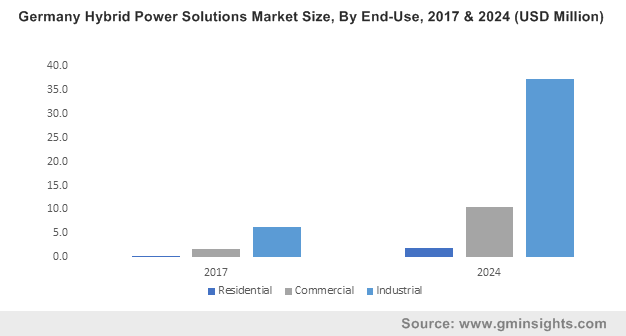Asia-Pacific hybrid power solution market to observe massive gains over 2018-2024, smart energy management systems to further stimulate the industry progression
Publisher : Fractovia | Published Date : 2018-08-02Request Sample
Increasing focus on developing alternate energy sources has boosted the hybrid power solution market, as implementation of multiple means of electricity generation is being preferred to support the existing power grids. While the electricity demand keeps on surging throughout the world, governments are working with power sector experts to promote the adoption of solar and wind energy, in a standalone capacity as well as within previously installed conventional energy systems. Integration of these renewable sources with any prevailing electricity gird strengthens its reliability and creates an efficient backup power supply, demonstrating how the hybrid power solution industry could help stabilize the power grids. Growing awareness regarding the environmental impact of fossil-fuel resources and increased pressure by consumers to harness renewable energy has driven the global hybrid power solutions market, which exceeded a valuation of USD 8 billion in 2017.
U.S. Hybrid Power Solutions Market Size, By End-Use, 2017 & 2024 (MW)

As the world is witnessing unprecedented levels of electricity consumption, the inefficiency of existing grid infrastructure is being realized and has stressed the need for developing continuous power supply, propelling the hybrid power solution market. The depleting reserves of conventional natural resources like coal and oil have coerced authorities to diversify their energy portfolio and incorporate sustainable energy within the power matrix. Electricity can now be produced by combining solar panels, wind turbines and diesel powered generators at a single power plant, ensuring uninterrupted supply and sufficient electricity backup. Eco-friendly hybrid plants without any fossil fuel-based equipment also exist, as cumulative harnessing of solar and wind power is becoming common at locations which receive enormous amount of sunlight and experience sufficiently strong winds. Communities and businesses operating in remote areas can achieve energy security due to reduced dependency on the unreliable single-source girds, enabling expansion of the hybrid power solutions market in developing countries.
With the largest concentration of emerging economies in the world, the Asia-Pacific region presents a tremendous opportunity for the evolution of the hybrid power solution industry, which is still in its early stages. According to a report, China, India and Japan contributed almost 75% of the total electricity production in 2017. Amongst these countries, China was responsible for half the production owing to rapid industrial progress and urbanization that necessitated the enhancement of power generating capacities. China and India are the two highest populated countries in the world and meeting the vast energy requirements has overstretched the grid capacity in most of the region, which is indicative of a lucrative future for the hybrid power solution industry in the region.
Additionally, concerns pertaining to air and water pollution have resulted in government legislations and initiatives that propagate sustainable energy, establishing a platform for the development of the hybrid power solution market. Citing an instance to signify the potential of the hybrid power solution industry in Asia-Pacific, Hero Future Energies recently finished installing India’s first ever large-scale solar-wind hybrid project in the southern state of Karnataka. As part of the project, a 28.8MW solar PV site was built near an existing 50MW wind farm, forming a hybrid power generation system. Both the wind and solar plants were developed by Hero and built by Siemens Gamesa using their turbines and inverters.
Further, the overall evacuation capacity of the Karnataka hybrid plant will remain at 50MW to address the grid-reliability issues related to variable power sourced from the renewable energy. Since the operations and supply infrastructure for both the plants are shared by one team, the project has effected cost reduction which in the end is reflected on the hybrid pricing. With the Ministry of New and Renewable Energy (MNRE) hinting at producing 10MW of energy from solar-wind hybrid by 2022, the new hybrid power system in Karnataka will encourage other companies to build similar projects in India, invariably bolstering the Asia-Pacific hybrid power solution market.
An important feature of hybrid power solution industry is the easy synchronization with smart technologies to raise the power supply efficiency, by managing the storage and diversion of electricity as when required. GE’s hybrid power plant in Berlin is a combination of Solar PV panels that produce electricity during the day and CHP technology which uses GE’s Jenbacher gas engine to generate power during night or in case of low sunlight. The energy produced from the system is stored in a flexible battery system, to account for surplus energy or when extra power is required to power GE’s Berlin facility.
Most significant benefit of GE’s Berlin hybrid plant is the intelligent energy management system, responsible for optimizing the energy production depending on the conditions and requirement. Integration with smart systems is a representation of the technological advancement achieved by the hybrid power solutions industry, which includes key players like GE, Wartsila, Gamesa, BWSC, Alpha Windmills and Blue Pacific Solar.